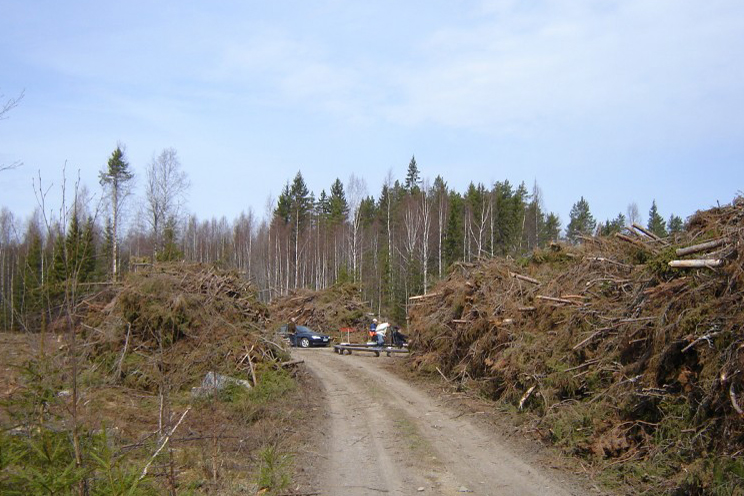Great leap in efficiency of Finnish wood supply system

Instead of just forecasting the future, the Finnish forest sector aims to construct a new wood supply system. The plan was to increase efficiency by 30 percent by 2025, but it now seems the target will be met five years ahead of time.
Wood supply refers to all activities resulting in the wood flow needed by the forest industry for its mills. The aim is to improve not only forest growth and the efficiency of forestry activities, but also the efficiency of wood harvesting, transport and pricing.
The key to progress here is digitalisation. However, digitalisation is by no means a new thing in the Finnish wood supply system, as it is based on the information systems of forest industry companies. As a result, the forest industry has long since been ahead of other Finnish industries in the use of mobile technology.
All data moving between the forest industry companies, the harvesting machines working in the forest and the wood-transporting lorries has long been transferred across a mobile phone network: maps of harvesting sites, harvesting plans, amounts of different grades of wood to be harvested, sites of intermediate wood storages and routes of wood-transporting lorries.
The new phase of digitalisation is based on the increasing volumes of data. There will be more and more of it, not only data on forest resources, but also information on weather conditions, soil, forest ownership, timber markets, as well as from all public information systems. Data created by research, information gathered in connection with forestry activities and by other forest users, such as recreational users, will also be included.
Grid units instead of compartments

The future of the wood supply system is planned by the Metsäteho research company within the Efficient Wood Supply 2025 vision. According to Mr. Heikki Pajuoja, Managing Director of Metsäteho, this is not a programme, but a strategy that will be updated continuously as circumstances change.
The aim is to increase the efficiency of all operations, starting in the forest and continuing to the mill gate. This is essential in a large country with long internal transport routes, situated far from the main market areas of the forest industry. All stakeholders involved in the forest industry are working together to create the vision: forest industry and forest owners, as well as wood harvesting and transporting entrepreneurs.
So far, the planning of forestry activities in Finland has been based on the concept of forest compartments. This is an area where the growing conditions, such as soil and microclimate, do not vary too much.
In the future, the basic unit of Finnish forestry will be a grid unit, a square measuring 16 metres on each side. Forest information will be linked to each grid unit, together with such additional information as live data on air humidity. This will be used to decide, among other things, whether the soil is dry enough to carry forest machinery.
Forest information will also be more detailed. In the future we will, for example, know how stout the trees in each wicket are.
Processing this information will not, however, be something that humans have to worry about. Instead, the data processing capacity of all machinery used in forests will increase considerably.
Management based on digitalisation, too
The use of digitalisation will be expanded to include logistics, structures, management, wood production and the timber market. Yet the strategy itself will not be overly detailed.
”The most important thing is to change our way of thinking. The changes will not be defined by the strategy, but by the participating stakeholders,” says Pajuoja.
In this way, the subcontractors will be free to work simultaneously for as many companies as they find reasonable.
As an example, when a timber deal is concluded, it will cover all the timber that can be reasonably harvested from the site, taking account of good forestry practices and the forest owner’s goals – whether or not the buyer needs all of it.
A regeneration felling, for example, usually produces timber in all sizes, and the buyer normally only needs some of it.
If, for example, your business is making pulp, you only need the small-diameter timber and the outer parts of the stout timber – the parts left after the log has been through a sawmill. Thus, you sell the stout timber to a sawmill, but you may agree that they will chip what they do not need and return it to your pulp mill.
In other words, there is an enormous lot of trading going on between Finnish forest industry companies. Yet the timber itself does not move from one storage to another with each deal. Instead, the aim is to move the timber as efficiently as possible to wherever it will be used. The potential for improving efficiency here is clearly huge.

Leap in efficiency is greater than planned
Most timber deals in Finland are concluded as stumpage sales. This means that the industry purchasing the timber will also harvest it.
In practice, harvesting is carried out by subcontractors. The forest machinery of the subcontractors is linked to the information systems of the relevant forest industry company. And, since each company has its own systems, the subcontractors have effectively been able to work for only one company.
The plan is to solve this problem by establishing special companies to manage the information systems. In the future, all parties will buy the IT services they need from these companies. In this way, the subcontractors will be free to work simultaneously for as many companies as they find reasonable.
”This means that the moving of forest machinery from one harvesting site to another will involve much shorter distances. As a result, the role of the subcontractors will change enormously,” says Pajuoja.
The Finnish Prime Minister Juha Sipilä has called for a five-percent increase in the productivity of Finnish labour. The target of the Efficient Wood Supply 2025 vision is six times that by the year 2025.
”At the moment it seems that the target will be reached, and actually by 2020. Nor is there any reason to believe that progress would stop there,” says Pajuoja.
Efficient Wood Supply 2025 vision

Kirjoita kommentti